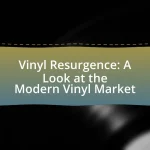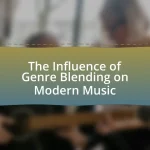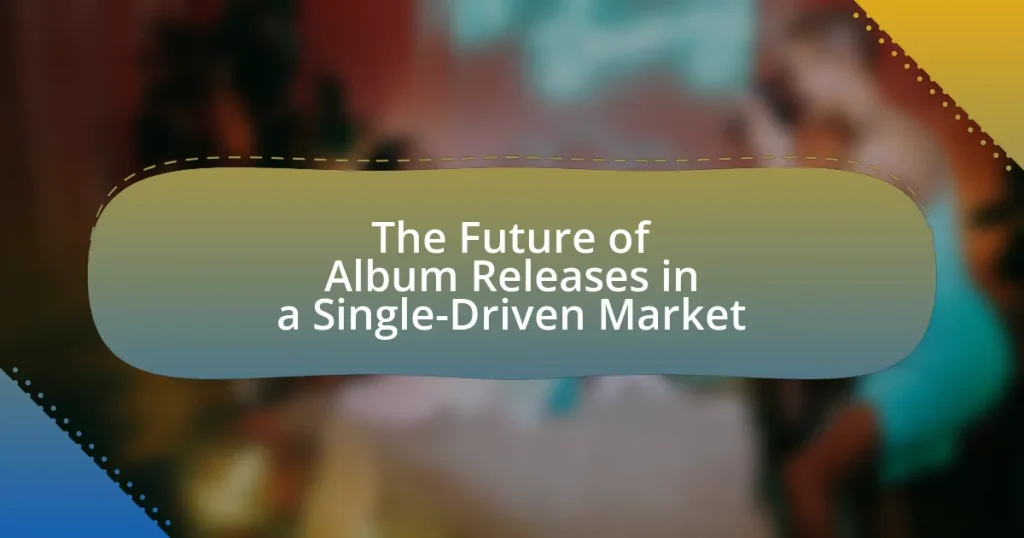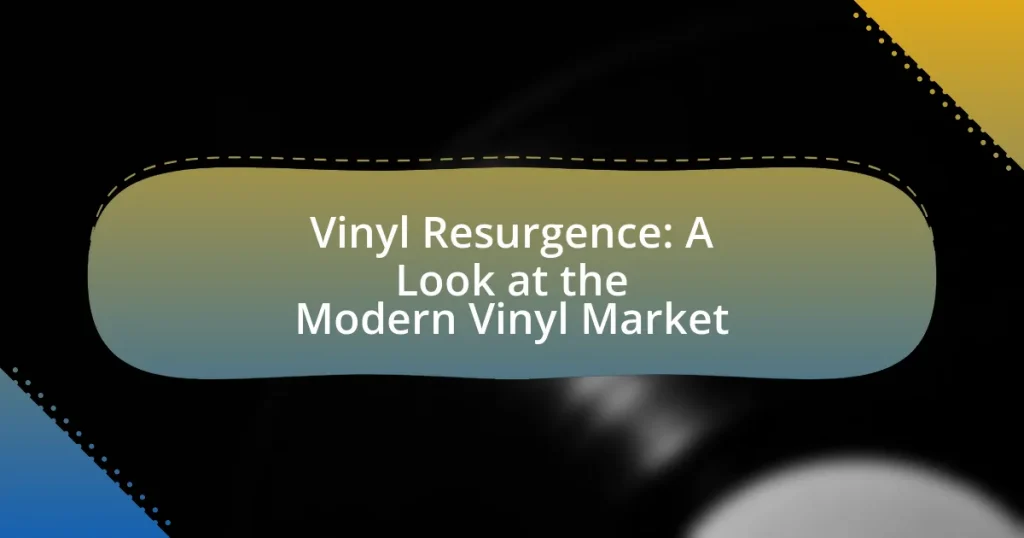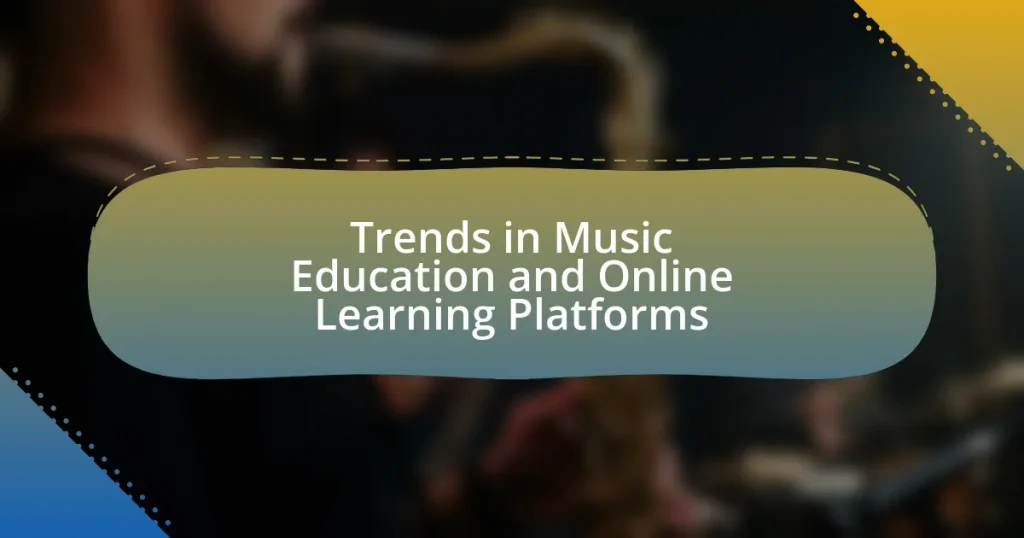The article examines the evolving landscape of album releases in a market increasingly dominated by singles. It highlights the shift in consumer behavior towards streaming platforms, where single track sales accounted for 80% of music revenue in 2022, leading artists to prioritize singles over cohesive albums. The discussion includes the impact of this trend on traditional album releases, emerging consumer listening habits, and the economic factors driving this change. Additionally, it addresses the challenges artists face in maintaining artistic integrity while navigating a single-driven market, as well as the potential future of album releases amidst technological advancements and changing audience engagement strategies.
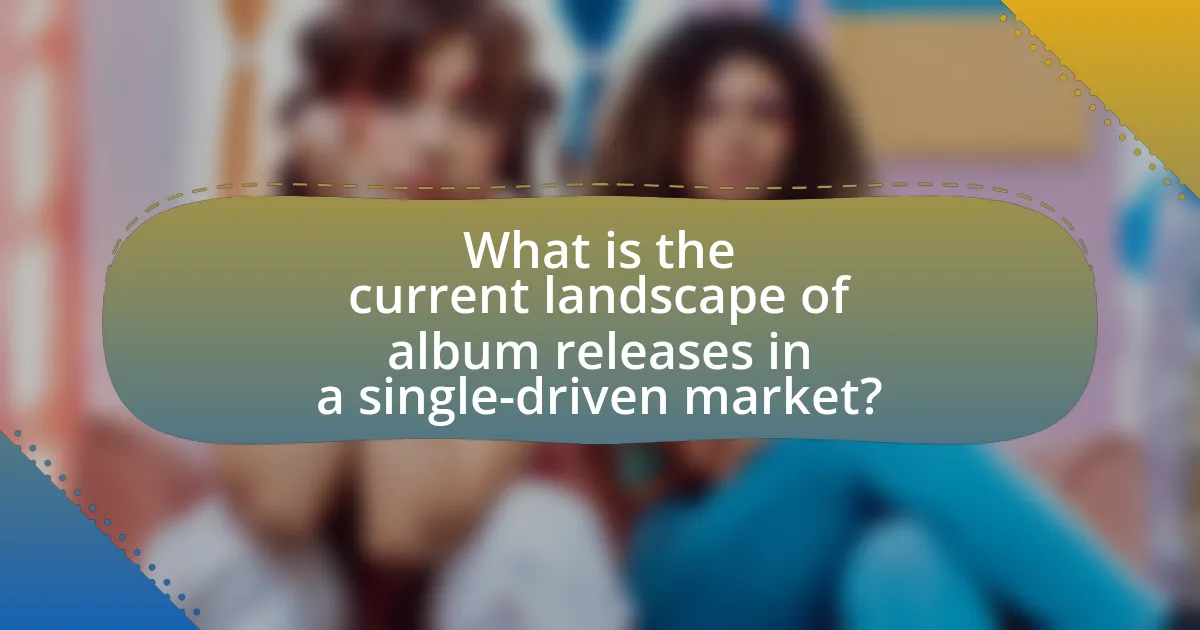
What is the current landscape of album releases in a single-driven market?
The current landscape of album releases in a single-driven market is characterized by a significant shift towards prioritizing singles over full albums. This trend is driven by consumer behavior that favors streaming platforms, where listeners often prefer to engage with individual tracks rather than entire albums. According to the Recording Industry Association of America (RIAA), in 2022, single track sales accounted for 80% of all music revenue, highlighting the dominance of singles in the market. Additionally, artists are increasingly releasing singles to maintain relevance and visibility in a crowded digital space, often leading to a fragmented listening experience where cohesive album narratives are less emphasized.
How has the rise of singles impacted traditional album releases?
The rise of singles has significantly diminished the prominence of traditional album releases. As consumer behavior shifts towards streaming platforms, artists increasingly prioritize releasing singles to maintain listener engagement and capitalize on immediate consumption trends. For instance, in 2020, the number of single releases surpassed album releases on platforms like Spotify, indicating a clear preference for shorter, more frequent content. This trend has led to a decline in album sales and a redefinition of how artists structure their music careers, often resulting in a focus on standalone tracks rather than cohesive albums.
What trends are emerging in consumer listening habits?
Emerging trends in consumer listening habits include a significant shift towards streaming services, increased preference for curated playlists, and a growing interest in short-form audio content. Streaming platforms like Spotify and Apple Music have reported that over 80% of music consumption now occurs through streaming, reflecting a decline in traditional album purchases. Additionally, consumers are gravitating towards personalized playlists, with Spotify’s “Discover Weekly” feature showcasing that 40% of users listen to curated playlists regularly. Furthermore, the rise of platforms like TikTok has popularized short-form audio clips, influencing music discovery and consumption patterns, as evidenced by the fact that songs trending on TikTok often see a substantial increase in streaming numbers.
How do streaming platforms influence the popularity of singles over albums?
Streaming platforms significantly influence the popularity of singles over albums by prioritizing individual tracks in their algorithms and playlists. This focus on singles allows artists to gain immediate visibility and traction, as playlists like Spotify’s “Today’s Top Hits” or Apple Music’s “Top 100” showcase popular songs rather than entire albums. According to a 2021 report by the International Federation of the Phonographic Industry, 70% of music consumption is driven by singles, highlighting the shift in listener behavior towards individual tracks. This trend is further supported by the fact that many listeners prefer to curate personalized playlists, which often feature singles rather than full albums, reinforcing the dominance of singles in the current music landscape.
Why are artists shifting their focus from albums to singles?
Artists are shifting their focus from albums to singles primarily due to the changing consumption habits of listeners. The rise of streaming platforms has made it easier for audiences to access and share individual tracks rather than full albums, leading to a preference for shorter, more frequent releases. Data from the Recording Industry Association of America (RIAA) indicates that single track sales have consistently outperformed album sales in recent years, reflecting this trend. Additionally, releasing singles allows artists to maintain a more consistent presence in the market, engage with fans regularly, and adapt quickly to trends, ultimately maximizing their reach and revenue potential.
What economic factors contribute to this shift?
The economic factors contributing to the shift towards single-driven markets include declining album sales, increased streaming revenue, and changing consumer behavior. Declining album sales have been evident since the early 2000s, with a 50% drop in physical album sales from 2000 to 2020, leading artists to focus on singles that generate immediate revenue. Increased streaming revenue, which surpassed $10 billion in 2020, incentivizes artists to release singles more frequently to capitalize on the platform’s pay-per-stream model. Additionally, changing consumer behavior, with listeners favoring curated playlists and shorter listening experiences, drives the demand for singles over full albums. These factors collectively reshape the music industry’s economic landscape, prioritizing single releases.
How does audience engagement differ between singles and albums?
Audience engagement differs significantly between singles and albums, primarily due to the consumption patterns and emotional investment associated with each format. Singles typically generate immediate attention and quick interactions, as they are often released to promote an artist’s presence and can quickly go viral, leading to high streaming numbers and social media buzz. In contrast, albums foster deeper engagement over a longer period, as listeners tend to invest time in exploring the entire body of work, often leading to a more profound emotional connection with the artist’s narrative and themes.
Research indicates that singles account for a substantial portion of streaming activity, with platforms like Spotify reporting that singles often receive more plays than album tracks. However, albums can lead to increased fan loyalty and sustained engagement through concert tours and merchandise sales, as fans often seek to experience the full artistic vision presented in an album. This distinction highlights how the format influences not only the initial engagement but also the long-term relationship between artists and their audiences.
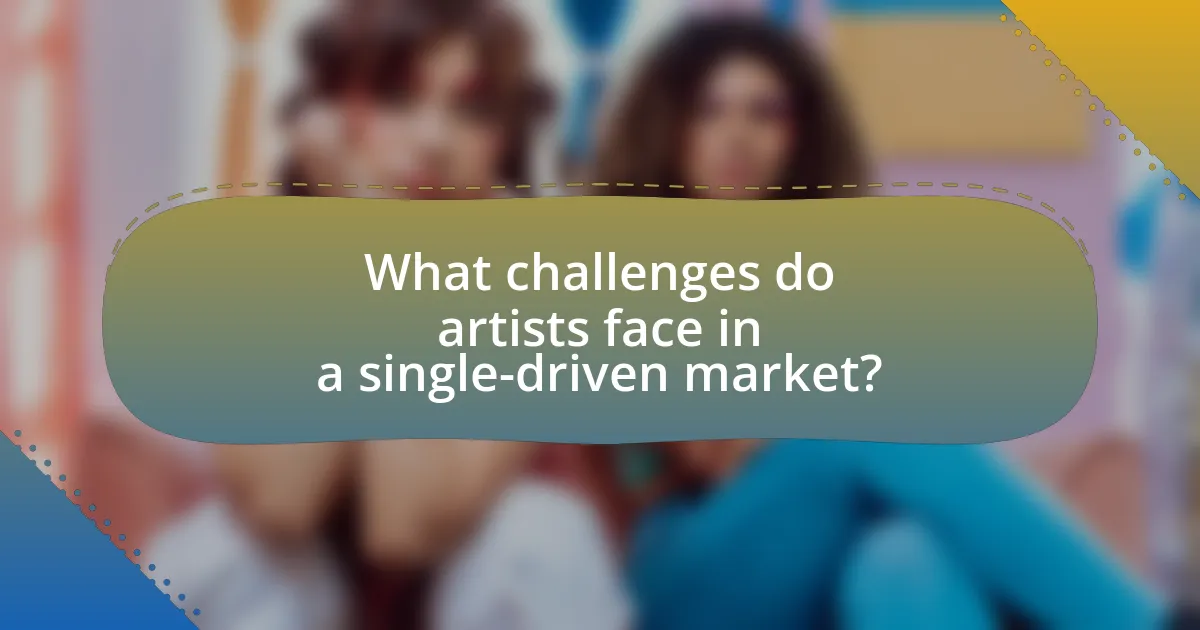
What challenges do artists face in a single-driven market?
Artists face significant challenges in a single-driven market, primarily due to the pressure to produce hit singles rather than cohesive albums. This focus on singles can lead to a lack of artistic expression, as artists may prioritize commercial viability over creative exploration. Additionally, the rapid consumption of music in a single-driven environment diminishes the perceived value of full albums, making it difficult for artists to justify the time and resources spent on album production. According to a report by the International Federation of the Phonographic Industry (IFPI), streaming services have shifted listener behavior towards singles, with 75% of music consumption now attributed to individual tracks rather than albums. This trend complicates artists’ ability to build a sustainable career based on traditional album sales and can result in financial instability.
How does the pressure to release singles affect artistic expression?
The pressure to release singles significantly constrains artistic expression by prioritizing commercial viability over creative exploration. Artists often feel compelled to produce catchy, radio-friendly tracks that align with market trends, which can lead to formulaic songwriting and a focus on short-term success rather than long-term artistic growth. For instance, a study by the University of Southern California found that the rise of streaming platforms has incentivized artists to release more singles, resulting in a decrease in the diversity and complexity of musical compositions. This trend reflects a shift in the music industry where the need for frequent releases can overshadow the depth and narrative cohesion typically found in full albums.
What are the implications for album storytelling and cohesion?
Album storytelling and cohesion are significantly impacted by the shift towards single-driven markets, as artists must now prioritize engaging narratives and thematic consistency within shorter formats. This change necessitates that musicians create compelling story arcs and maintain emotional resonance across fewer tracks, which can enhance listener engagement and retention. For instance, albums like Kendrick Lamar’s “To Pimp a Butterfly” demonstrate how cohesive storytelling can elevate the overall impact of the work, making it memorable and meaningful. The need for cohesion in a fragmented listening environment underscores the importance of intentional sequencing and lyrical continuity, which can lead to a more immersive experience for the audience.
How do artists balance commercial success with creative integrity?
Artists balance commercial success with creative integrity by strategically selecting projects that resonate with their artistic vision while also appealing to market demands. This often involves creating music that reflects their personal style and message, while also incorporating elements that are commercially viable, such as catchy hooks or collaborations with popular artists. For instance, many successful musicians, like Taylor Swift, have managed to maintain their artistic identity by evolving their sound and engaging with their audience through storytelling, which enhances both their commercial appeal and creative authenticity. This dual approach allows artists to achieve financial success without compromising their core values or artistic expression.
What marketing strategies are effective for promoting singles versus albums?
Effective marketing strategies for promoting singles include leveraging social media platforms for immediate engagement and utilizing streaming services for playlist placements, while album promotions benefit from comprehensive campaigns that include pre-release teasers, music videos, and coordinated release events. Research indicates that singles often gain traction through viral trends on platforms like TikTok, where short clips can lead to significant streaming numbers, whereas albums require a more sustained approach, often involving multiple promotional touchpoints to build anticipation and maintain listener interest over time. For instance, a study by Nielsen Music found that singles released with strong social media campaigns saw a 30% increase in first-week streams compared to those without, highlighting the effectiveness of targeted digital marketing for singles.
How can social media be leveraged to boost single releases?
Social media can be leveraged to boost single releases by utilizing targeted advertising, engaging content, and influencer partnerships. Targeted advertising on platforms like Facebook and Instagram allows artists to reach specific demographics, increasing visibility among potential listeners. Engaging content, such as behind-the-scenes videos, teasers, and interactive posts, fosters a connection with fans and encourages sharing, which amplifies reach. Collaborating with influencers who resonate with the artist’s target audience can further enhance exposure, as influencers often have established trust and credibility with their followers. According to a 2021 report by the International Federation of the Phonographic Industry, 70% of music consumers discover new music through social media, highlighting its effectiveness in promoting single releases.
What role do collaborations play in the success of singles?
Collaborations significantly enhance the success of singles by broadening their audience reach and increasing market visibility. When artists collaborate, they combine fan bases, which can lead to higher streaming numbers and sales. For instance, the single “Sicko Mode” by Travis Scott, featuring Drake, achieved over 1 billion streams on Spotify, showcasing how collaboration can amplify a song’s popularity. Additionally, collaborations often generate buzz and media attention, further driving engagement and interest in the single. This trend is supported by data indicating that tracks featuring multiple artists tend to perform better on charts compared to solo releases, highlighting the strategic advantage of collaborations in a single-driven market.

What does the future hold for album releases in a single-driven market?
The future of album releases in a single-driven market will likely see a continued emphasis on singles over full albums, as consumer behavior increasingly favors bite-sized content. Streaming platforms have shifted the focus to individual tracks, with data showing that over 70% of music consumption occurs through singles rather than albums. This trend suggests that artists may prioritize releasing multiple singles to maintain engagement and visibility, potentially leading to a decline in traditional album cycles. Additionally, the rise of social media platforms, where short clips of songs can go viral, further reinforces the single-driven model, compelling artists to adapt their release strategies accordingly.
How might technology shape the future of music releases?
Technology will significantly shape the future of music releases by enabling innovative distribution methods and enhancing audience engagement. Digital platforms like streaming services have already transformed how music is consumed, allowing artists to release singles and albums directly to listeners without traditional gatekeepers. For instance, in 2020, Spotify reported over 345 million users, illustrating the vast reach of digital platforms. Additionally, advancements in artificial intelligence and data analytics will allow artists to tailor their releases based on listener preferences, optimizing marketing strategies and timing. The rise of blockchain technology may also facilitate transparent royalty distribution, ensuring artists receive fair compensation. These technological advancements collectively indicate a shift towards more direct and personalized music release strategies.
What innovations are emerging in music distribution and consumption?
Innovations in music distribution and consumption include the rise of blockchain technology, which enhances transparency and security in royalty payments, and the use of artificial intelligence for personalized music recommendations. Blockchain allows artists to receive direct payments from consumers, reducing the need for intermediaries, while AI algorithms analyze listener behavior to curate tailored playlists, improving user engagement. According to a report by the International Federation of the Phonographic Industry, streaming services accounted for 62% of global recorded music revenues in 2021, highlighting the shift towards digital consumption and the importance of these innovations in shaping the future of music distribution.
How could virtual reality and augmented reality influence album experiences?
Virtual reality (VR) and augmented reality (AR) could significantly enhance album experiences by creating immersive environments that engage listeners on multiple sensory levels. VR can transport users into a virtual concert setting, allowing them to experience live performances as if they were physically present, which can deepen emotional connections to the music. AR can overlay digital content onto the real world, enabling fans to interact with album artwork or music videos in innovative ways, such as viewing 3D animations or accessing exclusive behind-the-scenes content through their devices. Research indicates that immersive experiences can lead to increased emotional engagement and retention of information, suggesting that these technologies could transform how audiences connect with music.
What are the potential benefits of returning to album-focused releases?
Returning to album-focused releases can enhance artistic expression and deepen listener engagement. Albums allow artists to explore themes and narratives in a cohesive manner, creating a more immersive experience for the audience. For instance, studies show that albums can lead to increased listener retention and emotional connection, as they encourage fans to invest time in the entire body of work rather than just individual tracks. Additionally, album releases can generate more significant promotional opportunities, such as tours and merchandise, which can lead to higher revenue streams for artists. Historical data indicates that successful albums often result in longer-lasting impact and recognition in the music industry compared to single releases, reinforcing the value of this approach.
How can artists create a compelling narrative through albums?
Artists can create a compelling narrative through albums by carefully structuring the tracklist to reflect a cohesive story or theme. This involves selecting songs that connect emotionally and thematically, allowing listeners to experience a journey from beginning to end. For example, Pink Floyd’s “The Wall” presents a clear narrative arc about isolation and personal struggle, engaging listeners through its lyrical and musical continuity. Additionally, artists can use interludes, skits, or spoken word segments to enhance storytelling, as seen in Kendrick Lamar’s “good kid, m.A.A.d city,” which provides context and depth to the album’s themes. By integrating these elements, artists can transform individual songs into a unified narrative experience that resonates with audiences.
What strategies can artists employ to revitalize album sales?
Artists can revitalize album sales by implementing targeted marketing strategies, engaging with fans through social media, and offering exclusive content. Targeted marketing, such as utilizing data analytics to identify listener demographics, allows artists to tailor their promotional efforts effectively. Engaging with fans on platforms like Instagram and TikTok fosters a sense of community and encourages direct interaction, which can lead to increased interest in album purchases. Additionally, offering exclusive content, such as limited edition vinyl, behind-the-scenes footage, or special merchandise bundles, creates a sense of urgency and value around the album, driving sales. For instance, Taylor Swift’s strategy of releasing exclusive merchandise with her album “Folklore” resulted in significant sales boosts, demonstrating the effectiveness of these approaches.
What practical tips can artists follow to navigate a single-driven market?
Artists can navigate a single-driven market by focusing on consistent content creation, engaging with their audience through social media, and leveraging data analytics to understand listener preferences. Consistent content creation helps maintain visibility and relevance, as artists who release singles regularly can keep their audience engaged and eager for more. Engaging with the audience through platforms like Instagram and TikTok fosters a community around the artist, which can lead to increased loyalty and support. Additionally, utilizing data analytics tools allows artists to track which songs resonate most with listeners, enabling them to tailor future releases to meet audience demands effectively. This approach is supported by the fact that artists who actively engage with their fan base and adapt to listener trends often see higher streaming numbers and fan retention.
How can artists effectively balance singles and albums in their release strategy?
Artists can effectively balance singles and albums in their release strategy by strategically timing single releases to build anticipation for an album while ensuring that the singles contribute to the overall narrative of the album. This approach allows artists to maintain engagement with their audience through regular content while also delivering a cohesive body of work. For instance, releasing a lead single several months before an album launch can generate buzz, as evidenced by Taylor Swift’s strategy with her album “Lover,” where she released multiple singles leading up to the album’s release, resulting in high pre-order numbers and chart success. Additionally, artists can use singles to test audience reactions to different styles or themes, allowing for adjustments before the album drops, as seen with Billie Eilish’s release of “When the Party’s Over” prior to her album “When We All Fall Asleep, Where Do We Go?” This method not only maximizes exposure but also aligns with the current market trend favoring singles, thus ensuring that artists remain relevant and connected to their fanbase.
What resources are available for artists to enhance their marketing efforts?
Artists can enhance their marketing efforts through various resources such as social media platforms, email marketing tools, and digital distribution services. Social media platforms like Instagram and TikTok allow artists to engage directly with their audience, showcasing their work and building a fanbase. Email marketing tools, such as Mailchimp, enable artists to communicate directly with fans, share updates, and promote new releases effectively. Digital distribution services like DistroKid and TuneCore facilitate the release of music across multiple streaming platforms, increasing visibility and accessibility. According to a 2021 report by the International Federation of the Phonographic Industry, digital music revenues grew by 19.9%, highlighting the importance of these resources in reaching wider audiences.

